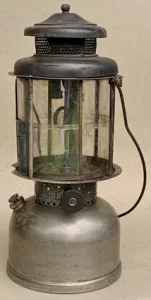Imagine a family camping trip in the late ’60s. The sun has dipped below the horizon, and the chill of the night is beginning to set in. As the stars start to twinkle, Dad pulls out the trusted Coleman lantern, giving it a few pumps before igniting it. The familiar hiss of the lantern coming to life and the warm, steady glow it emits brings a sense of comfort and adventure. For many, this scene is a cherished memory, a slice of the simpler times when family outings meant unplugging from the world and reconnecting with each other around the campsite.
The Coleman lantern, introduced in the early 20th century, has been a steadfast companion for campers, hikers, and outdoor enthusiasts. Its design has evolved over the decades, but its essence remains the same: a reliable source of light. During the ’50s and ’60s, these lanterns became synonymous with American outdoor culture. They were not just tools but symbols of exploration and the great outdoors.
The original Coleman lanterns used white gas, also known as Coleman fuel, providing a bright and steady light. These lanterns were prized for their durability and efficiency. The soft hum and glow of a Coleman lantern were often the backdrop for ghost stories, family meals, and moments of quiet reflection under the stars.
In the mid-20th century, outdoor activities surged in popularity. Families packed up their station wagons and headed to national parks, beaches, and campsites, seeking respite from the burgeoning urban lifestyle. The Coleman lantern became a staple of these trips, illuminating not just the campsite but also the spirit of post-war optimism and the burgeoning middle class’s love for recreation and nature.






